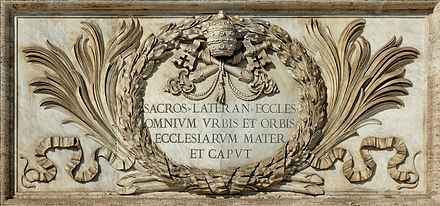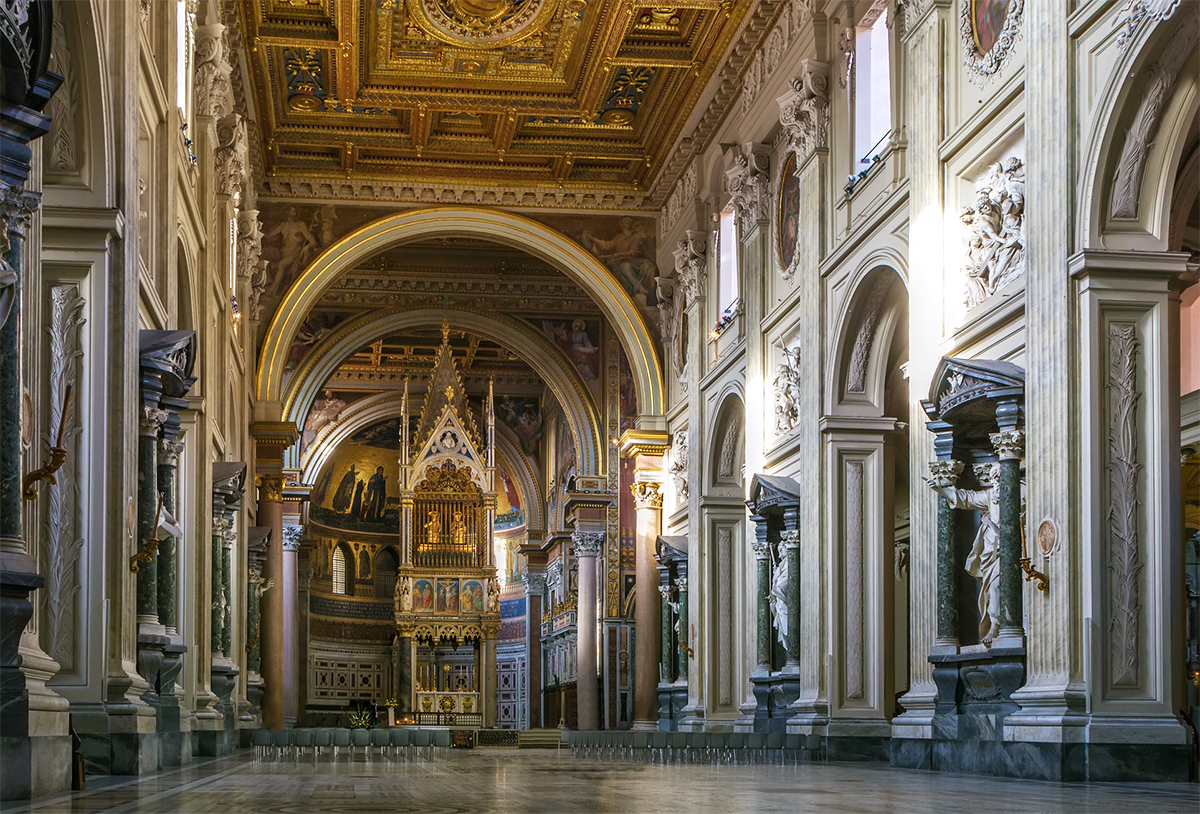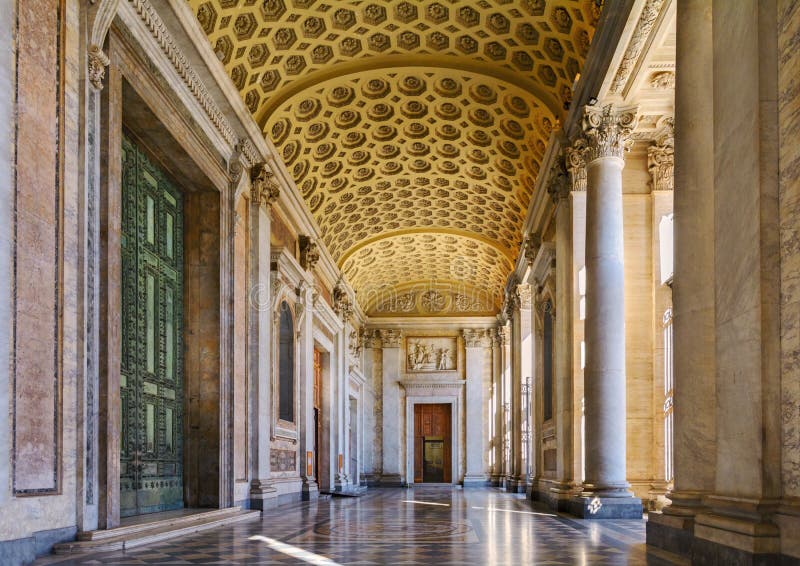
Out of all the Catholic churches in the world, that is, the physical buildings, which one ranks the highest? Many might answer "St. Peter's Basilica," but this is actually a common misconception. It is the Lateran Basilica which holds this unique honor. Its name, in full – and it is a mouthful – is the Cathedral of the Most Holy Savior and of Saints John the Baptist and John the Evangelist in the Lateran—and this church, being the Cathedral of the Bishop of Rome, has the singular dignity of being the mater et caput, "mother and head," of all the churches throughout the world. A cathedral, after all, is where a bishop's cathedra is to be found, and this is the seat, or "see," from which that bishop oversees his diocese, his particular church. In the case of the Supreme Pontiff, this is the seat whence he oversees the universal Church. Although there are four major basilicas, all in Rome, and numerous minor basilicas, all throughout the world, the Lateran alone, as the pope's cathedral, holds the privilege of being an archbasilica.
At its very origin, this basilica was part of a secular roman palace, belonging to the Laterani family, before it was confiscated by the Emperor Nero. It stayed in the emperor's possession until Emperor Constantine gave it to the Church, sometime before 313, and "From that time onwards it was always the centre of Christian life within the city; the residence of the popes and the cathedral of Rome."[1] While it is no longer the papal palace, it served in this capacity until the Avignon Papacy, after which the pope, returning to Rome, took up residence at the Vatican.[2] The basilica, consecrated in 324, was firstly, and remains principally, dedicated to the Saviour. In the year 580, when the Benedictine Abbey of Monte Casino was sacked by the Lombards, Pope Pelagius II sheltered the fleeing monks in the monastery attached to the basilica. When this monastery took Sts. John the Baptist and John the Evangelist as its patrons, the basilica came to be associated with their names, ultimately adopting them as the co-patrons of the basilica proper.[3] Thus the archbasilica came to be popularly known as "St. John Lateran."
The cathedral, as it stands today, is actually the fourth structure (roughly speaking), as its three predecessors were all more or less destroyed. The first building – likely being the original basilica (or meeting hall) of the Laterani palace, adapted to its new purpose rather than being newly constructed – survived until 896, when it was almost entirely destroyed by an earthquake. By this time, however, the interior of the basilica had already known a rise, a fall, and several restorations:
"A great many donations from the popes and other benefactors to the basilica are recorded in the "Liber Pontificalis", and its splendour at an early period was such that it became known as the "Basilica Aurea", or Golden Church. This splendour drew upon it the attack of the Vandals [in 455], who stripped it of all its treasures. St. Leo the Great restored it about 460, and it was again restored by Hadrian I [who reigned 772-795]."[4]
The next two structures were both destroyed by fire. The second church stood for four centuries before it burned. The third, built by Popes Clement V and John XXII, stood for less than a single century before it fell to a fire also in 1360. Finally, the current structure was erected under Urban V.[5] Throughout all of this, the Lateran Basilica retained the general form of its ancient design.

Under Pope Innocent X, during 1646-1650, the interior architecture of the archbasilica was significantly remodeled. The architect, Francesco Borromini, modernized the nave, encasing the slender pillars in large pilasters, creating niches which would eventually house twelve iconic rococo style statues of the apostles. While quite beautiful, this remodeling of the Lateran significantly changed its character.[6] The painting above gives a general idea of what the previous interior would have looked like, and this may be compared to the photograph of the current interior immediately below.

The archbasilica is positively riddled with sacred relics and fascinating historical artifacts. Chiefest among these are certainly those two relics housed in the baldacchino above the altar: the very skulls of both St. Peter and St. Paul. Concerning the altar itself, a quote is well deserving of our attention:
"The high altar... has no saint buried beneath it, since it was not, as were almost all the other great churches of Rome, erected over the tomb of a martyr. It stands alone among all the altars of the Catholic world in being of wood and not of stone, and enclosing no relics of any kind. The reason for this peculiarity is that it is itself a relic of a most interesting kind, being the actual wooden altar upon which St. Peter is believed to have celebrated Mass during his residence in Rome. It was carefully preserved through all the years of persecution, and was brought by Constantine and Sylvester from St. Pudentiana's, where it had been kept till then, to become the principal altar of the cathedral church of Rome. It is now, of course, enclosed in a larger altar of stone and cased with marble, but the original wood can still be seen." [7]
Interestingly enough, the great bronze doors of the Lateran are also pieces of history—trophies, as it were, from the same empire that martyred Sts. Peter and Paul: these doors once stood in the portals of the Curia Julia, the Roman Forum, and were moved to their new home at the command of Pope Alexander VII, who reigned from 1061 to 1073.[8]

"History, confirmed by the authority of Pontifical Bulls, informs us that Pope [St.] Silvester [who reigned from 313 to 335] established in the basilica built by the Emperor Constantine clerics living in common after the manner of the Primitive Church. In the year 492, [Pope St.] Gelasius, a disciple of St. Augustine... introduced in the patriarchal basilica the regular discipline which he had learnt at Hippo. Pope [St.] Gregory the Great, Eugenius II, Sergius III, and Alexander II, all endeavoured to maintain the observance of the regular life established among the clergy of the basilica. As relaxation had crept in, the last named pope, at the request of St. Peter Damian, called some canons from St. Frigidian at Lucca, a house of strict observance... The canons regular served the Lateran Basilica from the time they were put in possession till 1391, when secular canons were introduced by Boniface VIII. Several attempts were made to restore the basilica to its original owners, and finally Pope Eugenius IV, in 1445, gave it over to them... But the arrangement did not last long, and eventually the canons regular were definitively displaced, and the basilica made over to secular canons." [9]
Additionally, the refugee Benedictines of the sixth century, mentioned above, remained in the monastery joined to the Lateran for nearly a century and a half, and this closeness to the heart and head of Christianity helped to facilitate the popularity and spread of Benedictine monasticism.[10]
The Lateran is adorned also with the rich history of the countless saints who worshiped there. It is said that St. Francis and St. Dominic met for the first time in the Lateran.[11] "It was in the same Lateran Basilica, tradition tells us, that St. Patrick, the future Apostle of Ireland, professed the canonical institute which he afterwards introduced with the Christian Faith, into his own country"[12]. Moreover, it is an enchanting thought that, based on the history outlined above, St. Patrick, who lived from about 385 to 461, would have entered the pope's cathedral at the very height of its beauty, while it most deservedly enjoyed the appellation of Basilica Aurea.
__________________________________________
*An asterisk denotes that this source was found in the HACS Library
1. Arthur Barnes, "Saint John Lateran." The Catholic Encyclopedia. Vol. 9. (New York, NY: Robert Appleton Company, 1910), Accessed 12 Mar 2022 at http://www.newadvent.org/cathen/09014b.htm
2. Arthur Barnes, "Saint John Lateran."
3. George Cyprian Alston, "The Benedictine Order." The Catholic Encyclopedia. Vol. 2. (New York, NY: Robert Appleton Company, 1907), Accessed 12 Mar. 2022 at http://www.newadvent.org/cathen/02443a.htm
4. Arthur Barnes, "Saint John Lateran."
5. Arthur Barnes, "Saint John Lateran."
6. Arthur Barnes, "Saint John Lateran."
7. Arthur Barnes, "Saint John Lateran."
8. * Steven Fine, "Jewish Religious Architecture : From Biblical Israel to Modern Judaism." Brill, 2020.
9. Anthony Allaria, "Canons and Canonesses Regular." The Catholic Encyclopedia. Vol. 3. New York: Robert Appleton Company, 1908. 12 Mar. 2022 http://www.newadvent.org/cathen/03288a.htm.
10. George Cyprian Alston, "The Benedictine Order."
11. * “About the Pictures Saint John Lateran.” Sacred Music, vol. 110, no. 3, Fall 1983, p. 6. EBSCOhost, https://search.ebscohost.com/login.aspx?direct=true&AuthType=ip,cpid&custid=s9245834&db=aph&AN=64140622&site=ehost-live&scope=site.
12. Anthony Allaria, "Canons and Canonesses Regular."
No comments:
Post a Comment